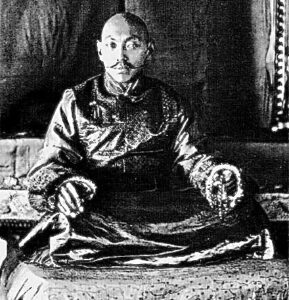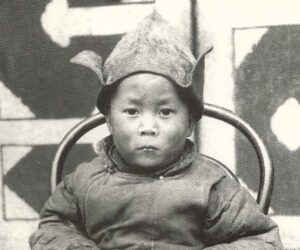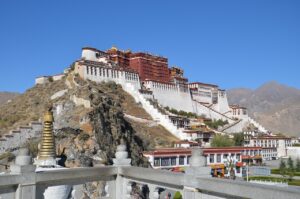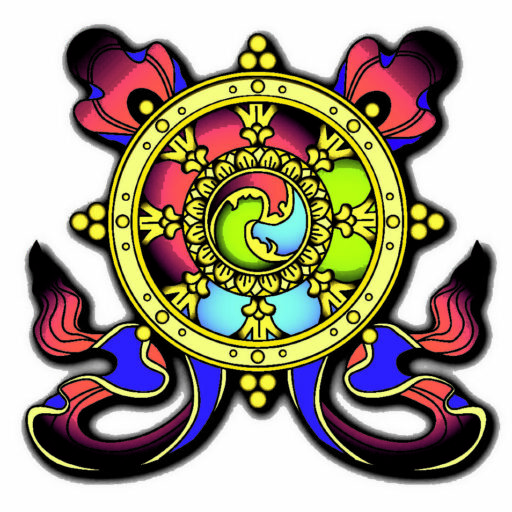by Margaret Florey
The search for His Holiness the 14th Dalai Lama is a story of patience, great persistence, and enormous joy.

In September 1936, three years after the death of the 13th Dalai Lama His Holiness Thubten Gyatso, a search party set out to find his incarnation, who would become the 14th Dalai Lama. The direction of the search party was guided by several signs that had been seen after the death of the 13th Dalai Lama.
First, the head of the embalmed body of the deceased Dalai Lama was twice discovered to have turned from facing south to facing the northeast. Next, the appointed Regent, Reting Rinpoche, went to Lake Lhama Latso in Chokhor Gyal to perform an intensive sadhana. In this sacred oracle lake, the Regent saw three Tibetan letters Ah, Ka and Ma. He also saw an image of a three-storied monastery with a turquoise and gold roof and a path running from it to a hill.
Finally, the vision revealed a small house with strangely shaped guttering. The Ah letter was interpreted as Amdo, the northeastern province and a Chinese frontier district, while the Ka letter was interpreted as indicating Kumbum monastery, which was three-storied and turquoise-roofed.
Search teams set out
Three search teams were then formed, and each went to different regions of eastern Tibet, taking with them various objects to test the candidates. The four-member Amdo team was led by Kewtsang Rinpoche and included Nagchu Khenpo Tsedrun Khenrab Tenzin, Tsedrung Lobsang Tsewang, and Khemey Sonam Wangdu.
This team carried the 13th Dalai Lama’s ritual mirror, while the other two teams took the 13th Dalai Lama’s rosary, damaru, and cane walking stick. It took some seven months for the Amdo team to reach Kumbun Jampaling monastery, which the search party recognised from the Regent’s vision. This monastery is also in the region in which Lama Je Tsong Khapa was born in 1367.
The four members of the Amdo team then went out to search different regions over several months, beginning with a list of fourteen candidates who had been identified through earlier searches. Kewtsang Rinpoche and his entourage went to the Takster region where Lhamo Thondup, the child who was to become the 14th Dalai Lama, lived. Kewtsang Rinpoche was disguised as a servant to the members of his entourage, who were dressed as pilgrims on their way to hermitages in Tsongkha.
Strong signs
In Chija Takster, the team members recognised the design of the house from the Regent’s vision. Kewtsang Rinpoche wore the 13th Dalai Lama’s rosary around his neck, and, as they were welcomed to the house, the young Dalai Lama candidate went up to him and joyfully pulled at the mala and asked that he be given it. He identified Rinpoche as a Sera Jey lama and begged to be taken with the search party when they left the following day.
Through further consultation via telegram, the Tibetan government showed its hope for the young candidate at Chija Takster and asked the team to examine him more closely. This time, the search members carried all the items from the late 13th Dalai Lama including a black rosary, walking stick, three quilts, and a hand drum. The two-year-old Lhamo Thondup was shown these objects which were placed alongside other similar items. To the quiet joy of the team, he correctly identified each item with ease.

Confirmation
A detailed coded report was sent both by telegram and by horseback messenger to the Tibetan Government. Several months passed before a reply was received confirming that the visions and the tests had indeed identified Lhamo Thondup to be the true reincarnation of the Thirteenth Dalai Lama.
Due to the treacherous circumstances under the regional Chinese Governor Ma Bufeng, the Government insisted on strict confidentiality to ensure the safety of the young Dalai Lama before he could be brought to Lhasa. Due to the dangers, even Lhamo Thondup’s family could not be told of their son’s identification and were advised that the Government had requested that three candidates be brought to Lhasa for further testing.
Journey to Lhasa
Many months passed while the team members negotiated the Governor’s increasingly difficult demands. Eventually, in June 1939, they were able to set out for Lhasa with the young Dalai Lama and his family. As the entourage travelled closer to Lhasa and reached safer territory, the family were able to learn the truth of their son’s identification.

In the later days of this lengthy journey, local peoples and high-ranking monastic officials came out in great numbers along the way to greet the young Dalai Lama and his entourage with colourful ceremonies.
Finally, on the auspicious day of the 25th of August 1939, the party entered Lhasa in a magnificent procession. Thus began the formal steps to enthrone the 14th Dalai Lama, His Holiness Tenzin Gyatso.
This article draws primarily on Discovery, Recognition and Enthronement of the 14th Dalai Lama: A Collection of Accounts by Khemey Sonam Wangdu, Sir Basil J. Gould, Hugh E. Richardson (2000 Library of Tibetan Works and Archives)
You can also read in this edition “The tulku and rinpoche system in Tibetan Buddhism”
